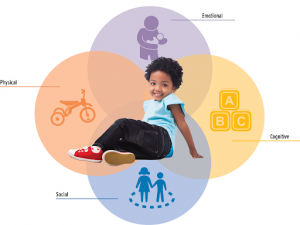Psychology Notes On – Aspects Of Emotional Development Of Children – For W.B.C.S. Examination.
The theoretical perspective taken toward emotional development in childhood is a combination of functionalist theory and dynamical systems theory.Continue Reading Psychology Notes On – Aspects Of Emotional Development Of Children – For W.B.C.S. Examination.
A child’s encounters with an environment can be seen as dynamic transactions that involve multiple emotion-related components (e.g., expressive behaviour, physiological patterning, action tendencies, goals and motives, social and physical contexts, appraisals and experiential feeling) that change over time as the child matures and in response to changing environmental interactions. Emotional development reflects social experience, including the cultural context.
Table 1 summarizes noteworthy descriptive markers of emotional development in relation to social interaction.
|
Age Period |
Regulation/Coping |
Expressive Behavior |
Relationship Building |
|
Infancy: |
Self-soothing and learning to modulate reactivity. Regulation of attention in service of coordinated action. Reliance on caregivers for supportive “scaffolding” during stressful circumstances. |
Behavior synchrony with others in some expressive channels. Increasing discrimination of others’ expressions. Increasing expressive responsiveness to stimuli under contingent control. Increasing coordination of expressive behaviors with emotion-eliciting circumstances. |
Social games and turn-taking (e.g., “peek-a-boo”). Social referencing. Socially instrumental signal use (e.g., “fake” crying to get attention). |
|
Toddlerhood: |
Emergence of self-awareness and consciousness of own emotional response. Irritability due to constraints and limits imposed on expanding autonomy and exploration needs. |
Self-evaluation and self-consciousness evident in expressive behavior accompanying shame, pride, coyness. Increasing verbal comprehension and production of words for expressive behavior and affective states. |
Anticipation of different feelings toward different people. Increasing discrimination of others’ emotions and their meaningfulness. Early forms of empathy and prosocial action. |
|
Preschool: |
Symbolic access facilitates emotion regulation, but symbols can also provoke distress. Communication with others extends child’s evaluation of and awareness of own feelings and of emotion-eliciting events. |
Adoption of pretend expressive behavior in play and teasing. Pragmatic awareness that “false” facial expressions can mislead another about one’s feelings. |
Communication with others elaborates child’s understanding of social transactions and expectations for comportment. Sympathetic and prosocial behavior toward peers. Increasing insight into others’ emotions. |
|
Early Elementary School: 5-7 years |
Self-conscious emotions (e.g., embarrassment) are targeted for regulation. Seeking support from caregivers still prominent coping strategy, but increasing reliance on situational problem-solving evident. |
Adoption of “cool emotional front” with peers. |
Increasing coordination of social skills with one’s own and others’ emotions. Early understanding of consensually agreed upon emotion “scripts.” |
|
Middle Childhood: |
Problem-solving preferred coping strategy if control is at least moderate. Distancing strategies used if control is appraised as minimal. |
Appreciation of norms for expressive behavior, whether genuine or dissembled. Use of expressive behavior to modulate relationship dynamics (e.g., smiling while reproaching a friend). |
Awareness of multiple emotions toward the same person. Use of multiple time frames and unique personal information about another as aids in the development of close friendships. |
|
Preadolescence: |
Increasing accuracy in appraisal of realistic control in stressful circumstances. Capable of generating multiple solutions and differentiated strategies for dealing with stress. |
Distinction made between genuine emotional expression with close friends and managed displays with others. |
Increasing social sensitivity and awareness of emotion “scripts” in conjunction with social roles. |
|
Adolescence: |
Awareness of one’s own emotion cycles (e.g., guilt about feeling angry) facilitates insightful coping. Increasing integration of moral character and personal philosophy in dealing with stress and subsequent decisions. |
Skillful adoption of self-presentation strategies for impression management. |
Awareness of mutual and reciprocal communication of emotions as affecting quality of relationship |
Please subscribe here to get all future updates on this post/page/category/website


 Toll Free 1800 572 9282
Toll Free 1800 572 9282  mailus@wbcsmadeeasy.in
mailus@wbcsmadeeasy.in



















































































































